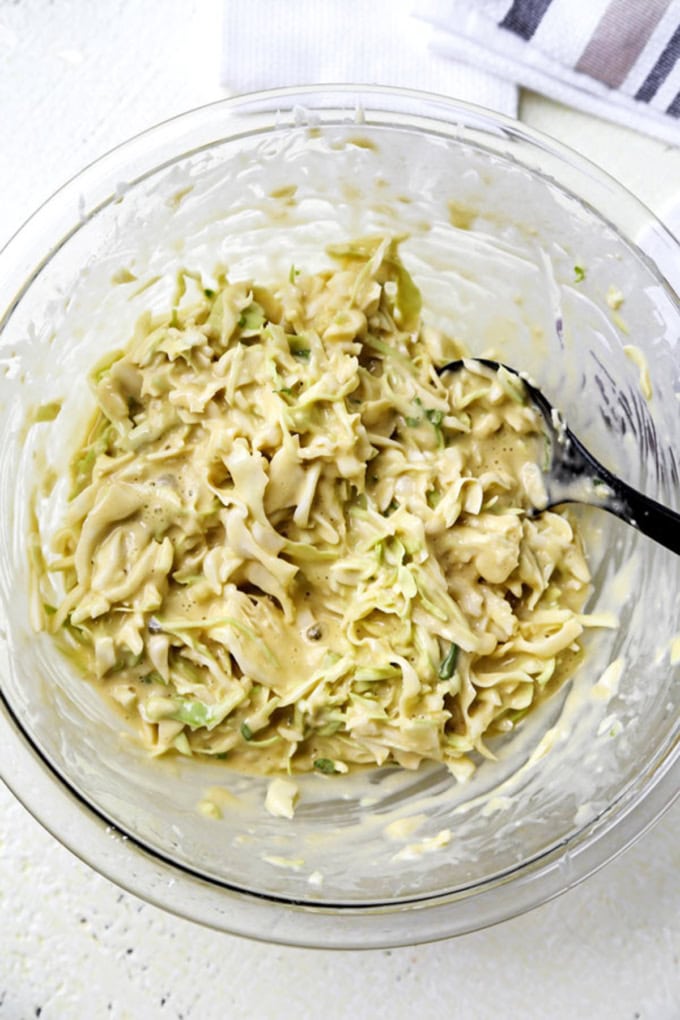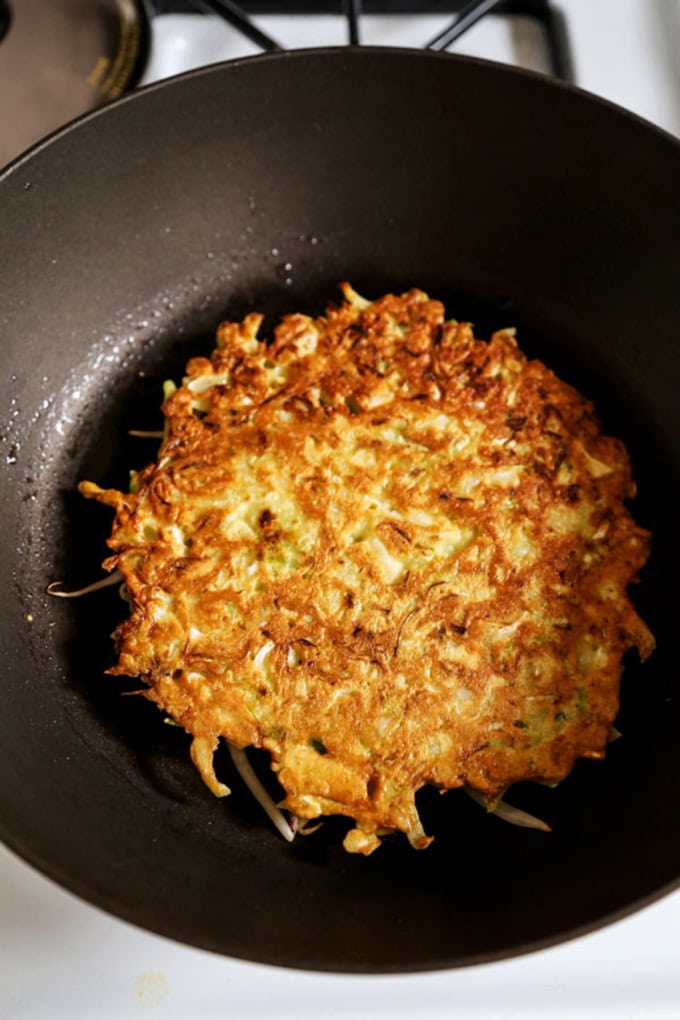I fill my homemade okonomiyaki with cabbage and bean sprouts. Then I top with katsuobushi, Japanese mayo and sweet and tangy okonomi sauce. So easy! Seriously, it just takes me 20 minutes to make this Osaka style recipe at home. Is it kid friendly? I told my niece it was Japanese pizza and she wolfed it down.

My uncle Ken introduced my brother and me to okonomiyaki on a family trip to Japan when we were kids. We sat at bar with a teppanyaki grill top – and a chef ambled over with a bowl of batter that contained cabbage and a mix of seafood. He poured a ladle full onto the grill top and shaped the batter into a perfect circle. We watched in awe as it bubbled, our stomachs growling. When I took my first bite, I had a food revelation. Here was a crispy yet fluffy savory pancake topped with Japanese mayo, okonomiyaki sauce and katsuobushi (bonito flakes) – and it was one of the best things I had ever tasted in my short life. I wanted more.
So when I set out to make homemade okonomiyaki, I did it with that magical experience in mind.
What is Okonomiyaki? Expand for More.
Okonomiyaki – お好み焼き – is a savory Japanese pancake. The batter is made of flour, mountain yam (nagaimo) and dashi. Some pancakes include pork belly, or seafood or a fried egg. There are even some that use more eclectic ingredients like mochi or even cheese. And the freedom to use those different ingredients is reflected in the meaning of the name.
The word okonomiyaki is derived from two words in the Japanese language:
- Okonomi means roughly ‘how you like’.
- Yaki translates into ‘grill’.
Therefore, grilled how you like it is pretty close to its literal meaning.
Table of Contents

Ingredients Needed
- Flour: I use Osaka style okonomiyaki flour, which yields a rich and fluffy dough.
- Dashi: Dashi is a Japanese sea stock that acts as the savory, umami bedrock in tons of Japanese recipes. When I’m in a hurry, I use powdered dashi (1 teaspoon per 1 cup of water). When I’ve got time, I make homemade dashi broth from scratch.
- Green Cabbage: The best crunch and so refreshing. I always make sure it’s sliced very thinly.
- Green Onions: Thinly chopped scallions add more crunch and a little sharp sweetness to the batter. I make sure to reserve an extra teaspoon to sprinkle on top of the cooked pancake too.
- Eggs: I use 2 large pasture raised eggs for this recipe.
- Oil: Any type of neutral oil works here. I prefer grapeseed oil.
- Bean Sprouts: About a cup of fresh sprouts will do it.
Okonomiyaki Toppings
These are my favorites:
- Katsuobushi – smoky bonito flakes
- Beni Shōga – pickled red ginger
- Kewpie Mayonnaise – or try making homemade Japanese mayo
- Okonomi Sauce – tonkatsu sauce is a great alternative
- Aonori – powdered or flaked green laver


How to Make Okonomiyaki
- Make the batter. Pour 1 cup Osaka style okonomiyaki flour in a bowl along with 3/4 cup dashi and whisk until the flour has dissolved and the batter is smooth. Then stir in the whisked eggs, scallions, and shredded cabbage. Mix well.
- Cook the pancakes. Add 1 tablespoon of oil to a medium pan over medium high heat and once the oil is hot, ladle one third of the okonomiyaki batter into the pan. Shape the batter into a pancake about a half-inch thick. Place the bean sprouts on top of the pancake a cook for 4 minutes.
- Flip it! Flip the pancake and cook for 3 minutes.
- Garnish and dress the pancakes. Transfer the pancake to a plate and top with kewpie mayonnaise, okonomi sauce, bonito flakes (katsuobushi), and red pickled ginger (beni shōga).
Recipe Variations
While okonomiyaki is served all throughout Japan, my recipe is based on Osaka okonomiyaki served in the Kansai region. That means I mixed the vegetables into the batter directly. But here are some common additions.
- Meat. Thinly sliced pork belly is delicious.
- Seafood. I love squid, shrimp and scallops.
- Yakisoba noodles. In Osaka okonomiyaki, if you use noodles, they are added to the batter with the veggies, meat and seafood. This type is called modanyaki.
Hiroshima style okonomiyaki relies on most of the same basic ingredients as the Osaka version – however everything is layered. The ingredients are piled one on top of the other in a neat, circular stack. Here are a couple of common additions for Hiroshima-yaki.
- Fried egg. Hard egg-white, runny yolk. Yum. This is in addition to the eggs used in the batter.
- Yakisoba noodles. In Hiroshima okonomiyaki, the fried noodles are not added to the batter – but compose a layer in the ‘stack.’


Storage and Reheating
Store ungarnished leftovers on a plate covered with plastic wrap – or in an airtight food storage container – in the refrigerator for up to 2 days.*
- Reheat in a pan on the stovetop with a teaspoon of oil. Once hot, transfer to a plate. Top reheated pancakes with mayo, tonkatsu sauce, katsuobushi and freshly chopped green onions.
* I only recommend saving leftover okonomiyaki if the pancake isn’t already topped with sauce. If it’s drenched in sauce, I’m afraid it’s only going to get mushy and waterlogged in the fridge.

What to Serve with Okonomiyaki
When I serve okonomiyaki for dinner, I know it’s it’s going to steal the spotlight. So I usually serve a simple green salad with Japanese dressing or small side dishes that will compliment the flavors of the Japanese pizza. Some of my favorite go-to dishes are:
- Japanese Fried Rice (Yakimeshi)
- My Mom’s Miso Soup
- Edamame With Soy and Sesame Sauce
- Shiraae (Japanese Mashed Tofu Salad)
- Nasu Dengaku – Miso Glazed Eggplant

Frequently Asked Questions
The stovetop heat might not be high enough. I usually opt for medium-high for best results. You want to cook it so it’s golden brown on the outside. But the inside should still be chewy.
When it’s not fully cooked on the inside, that usually means the pancake is too thick – or is overloaded with too many ingredients. I’ve found that homemade okonomiyaki works best when it’s around 1/4 inch to 1/2 thick.
Believe it or not, thin okonomiyaki batter is usually due excess moisture from wet cabbage. After rinsing your cabbage, be sure to dry it. I shake the water off after rinsing the cabbage head – and blot my shredded cabbage with paper towels after cutting. I also dry the bean sprouts after rinsing.
You can use tonkatsu sauce instead. The flavors are similar. It’s fairly easy to track down online – or you can make tonkatsu sauce from scratch super easily.
I think it’s best hot and fresh out of the pan. If you decide to pre-make the pancakes and serve later, be sure not to add any toppings or sauces until just prior to serving.

Did you like this okonomiyaki recipe? Are there changes you made that you would like to share? Share your tips and recommendations in the comments section below!
Print
Okonomiyaki
- Prep Time: 10 minutes
- Cook Time: 10 minutes
- Total Time: 20 minutes
- Yield: 3 pancakes
- Category: Main
- Method: Skillet
- Cuisine: Japanese
Description
My homemade okonomiyaki (Japanese pizza) is filled with cabbage and bean sprouts. Top with katsuobushi, Japanese mayo and sweet and tangy okonomi sauce. So easy to make from scratch!
Ingredients
Pancakes
- 1 cup Osaka style okonomiyaki flour
- 3/4 cup dashi
- 10.5 ounces green cabbage, shredded
- 2 scallions, chopped
- 2 eggs, whisked
- 2 tablespoons neutral oil such as vegetable or grapessed oil
- 1 cup bean sprouts
Toppings
- Bonito flakes
- Pickled red ginger (beni shoga)
- Kewpie mayonnaise or regular mayonnaise
- Okonomi sauce or tonkatsu sauce
- Aonori (green laver)
Instructions
- Make the okonomiyaki batter. In a large bowl, add the okonomiyaki flour and stir in the dashi broth until the flour dissolves. Add the cabbage, scallions and eggs and mix well.
- Cook the pancakes. In a large skillet over medium high heat, add 1 tablespoon oil and swirl to coat the surface evenly. Pour 1/3 of the mixture into the skillet and shape into a 1/2-inch thick pancake. Top with 1/3 of the bean sprouts and cook for 4 minutes, until the bottom is golden brown.
- Cook the other side. Flip the pancake and cook for 3 minutes, until bean sprouts are cooked.
- Garnish and dress the pancakes.Transfer to a plate and top with okonomi sauce, kewpie mayonnaise, bonito flakes, pickled ginger, and aonori. Serve.
Repeat the same steps for the remaining 2 pancakes.
Notes
Keep the leftovers in an airtight storage container, or on a plate covered with plastic wrap. Refrigerate for up to 3 days.
Nutrition
- Serving Size: 1 pancake
- Calories: 291
- Sugar: 5.6g
- Sodium: 218mg
- Fat: 8.9g
- Saturated Fat: 2.8
- Unsaturated Fat: 2g
- Trans Fat: 0g
- Carbohydrates: 41.6g
- Fiber: 3.9g
- Protein: 12.3g
- Cholesterol: 129mg















This was delicious and easy to make! It is definitely going into the meal rotation. Thank you
Thank you so much Kai!
Hello Caroline, I’m new to your site and came across your okonomiyaki recipe. Any suggestions how to veganize this dish though? Thank you!
Hi Jin! I have never made okonomiyaki vegan but I would suggest swapping the dashi broth for a kombu based dashi or just water with a little salt. For eggs, use flaxseed eggs which are very easy to make – mix 1 tablespoon ground flaxseed with 2 tablespoons flour (equals one egg) and let the mixture rest for 5 minutes before using. Otafuku’s Okonomiyaki flour is vegan so you can use that and their sauce as well 🙂 Let me know how it turns out! Oh, and instead of bonito flakes you can use plenty of shredded nori!
Is it possible to use Almond flour for this receipe?
Hi Jean! Unfortunately I don’t think almond flour would work for this because of the textural aspect. If you are gluten intolerant, I would use gluten-free flour, which should work just fine :).
This looks amazing! I love OKONOMIYAKI! I was wondering if you make your own Japanese mayo? If so, do you have a recipe? Thanks so much! Looking forward to making this!
To make it GF can we use tapioca flour? 🙂
Hi Marcy! I do have a Japanese mayo recipe here -> https://pickledplum.com/japanese-mayo-kewpie/ 🙂 I’m not sure about tapioca flour to make okonomiyaki since I’ve never used it, but regular gluten-flour does the trick 🙂
Hello! I wanted to tell you that for GF version I have used 1/2 cup rice flour and 1/2 cup tapioca flour and it was awesome! I posted it on our IG @ twobitches_inakitchen and mentioned you! Thanks for your awesome recipes! We eat this weekly and is one of our fav meals!
That’s wonderful Marcy!! Thank you for sharing 🙂
What would you suggest if you can’t get the okonomiyaki flour? (Not in US, amazon will not deliver here) The local Japan shop only does mail order business, but at least has the Kewpie mayo and okonomiyaki sauce.
Hi Motomachi!
You can use all-purpose flour and add a little potato starch or corn starch to it to make the batter more sticky. For every 100g all-purpose you use, add about 20g of potato or corn starch. I hope this helps! 🙂
This pizza looking colorful and delicious. Procedure is also simple. Nice recipe.